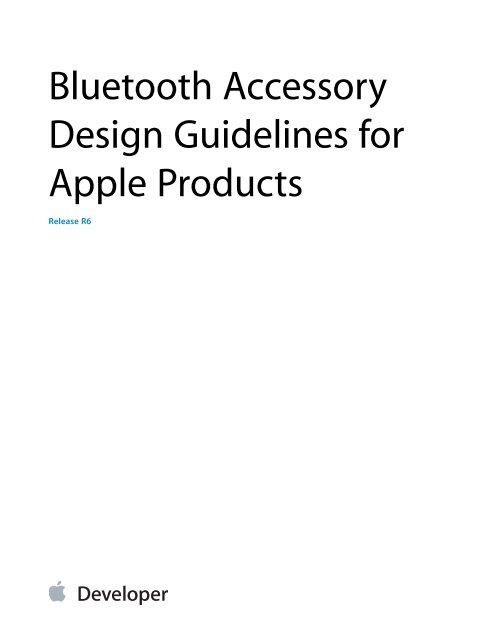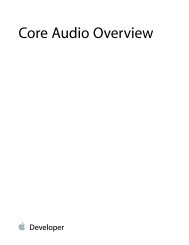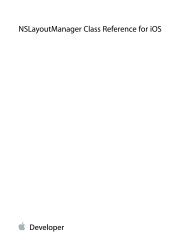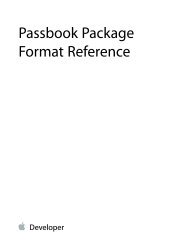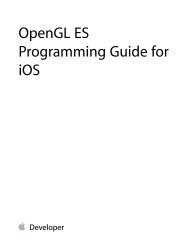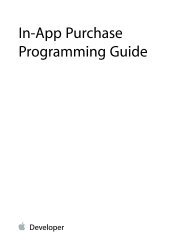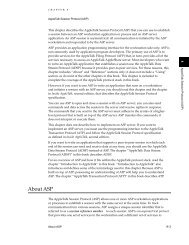Bluetooth Accessory Design Guidelines for Apple ... - Apple Developer
Bluetooth Accessory Design Guidelines for Apple ... - Apple Developer
Bluetooth Accessory Design Guidelines for Apple ... - Apple Developer
Create successful ePaper yourself
Turn your PDF publications into a flip-book with our unique Google optimized e-Paper software.
<strong>Bluetooth</strong> <strong>Accessory</strong><br />
<strong>Design</strong> <strong>Guidelines</strong> <strong>for</strong><br />
<strong>Apple</strong> Products<br />
Release R6
Contents<br />
Introduction 5<br />
Organization of This Document 5<br />
General Requirements 6<br />
Con<strong>for</strong>mity With <strong>Bluetooth</strong> Specifications 6<br />
Enhanced Data Rate 6<br />
Sniff Mode <strong>for</strong> Low Power Consumption 6<br />
Role and Topology Management 7<br />
Extended Inquiry Response 7<br />
Secure Simple Pairing 8<br />
Profiles 8<br />
Device ID Profile (DID) 8<br />
Hands-Free Profile (HFP) 9<br />
Message Access Profile (MAP) 11<br />
Audio/Video Remote Control Profile (AVRCP) 11<br />
Advanced Audio Distribution Profile (A2DP) 14<br />
Audio Routing 15<br />
Audio Data Received via HFP Profile 16<br />
Audio Data Received via A2DP Profile 16<br />
<strong>Bluetooth</strong> Low Energy 17<br />
Role 17<br />
Advertising Channels 17<br />
Advertising PDU 17<br />
Advertising Data 17<br />
Advertising Interval 18<br />
Connection Parameters 18<br />
Privacy 19<br />
Permissions 19<br />
Pairing 19<br />
Services 19<br />
GATT Server 20<br />
<strong>Apple</strong> Protocols and <strong>Developer</strong> Support 21<br />
<strong>Apple</strong> <strong>Bluetooth</strong> Development Mailing List 21<br />
2012-11-06 | © 2012 <strong>Apple</strong> Inc. All Rights Reserved.<br />
2
Contents<br />
The iPod <strong>Accessory</strong> Protocol 21<br />
Headset Battery Level Indication 21<br />
HFP Command AT+XAPL 22<br />
HFP Command AT+IPHONEACCEV 22<br />
Document Revision History 24<br />
2012-11-06 | © 2012 <strong>Apple</strong> Inc. All Rights Reserved.<br />
3
Tables<br />
General Requirements 6<br />
Table 1-1 SubBand Codec In<strong>for</strong>mation Elements <strong>for</strong> <strong>Apple</strong> products 14<br />
Table 1-2 MPEG-2/4 AAC Codec In<strong>for</strong>mation Elements <strong>for</strong> iOS devices 14<br />
Table 1-3 AAC audio packet <strong>for</strong> iOS devices 15<br />
2012-11-06 | © 2012 <strong>Apple</strong> Inc. All Rights Reserved.<br />
4
Introduction<br />
This document presents design guidelines <strong>for</strong> hardware accessories that use <strong>Bluetooth</strong> transport to communicate<br />
with <strong>Apple</strong> products, including Mac, iPhone, iPad, and iPod touch models.<br />
Note: This document is a draft and is subject to change without notice.<br />
To be compatible with <strong>Apple</strong> products, both current and future, <strong>Bluetooth</strong> accessories should follow the<br />
specifications in this document.<br />
IMPORTANT: This document uses the term “<strong>Apple</strong> product” to refer generically both to Mac (<strong>Apple</strong><br />
computers that run OS X) and to iPod, iPhone, and iPad models. Among the latter products, those<br />
that run iOS (<strong>Apple</strong>’s mobile operating system) are also referred to as “iOS devices.” Specifications<br />
in this document that are designated <strong>for</strong> iOS devices apply only to those products.<br />
Organization of This Document<br />
The specifications in this document are presented in three chapters:<br />
● “General Requirements” (page 6) relates the design of hardware accessories that use <strong>Bluetooth</strong> transport<br />
to the general <strong>Bluetooth</strong> specification.<br />
● “<strong>Apple</strong> Protocols and <strong>Developer</strong> Support” (page 21) references an <strong>Apple</strong> protocol that can extend accessory<br />
capabilities beyond those supported by standard <strong>Bluetooth</strong> profiles.<br />
2012-11-06 | © 2012 <strong>Apple</strong> Inc. All Rights Reserved.<br />
5
General Requirements<br />
Con<strong>for</strong>mity With <strong>Bluetooth</strong> Specifications<br />
Every <strong>Bluetooth</strong> accessory that is compatible with an <strong>Apple</strong> product should support the <strong>Bluetooth</strong> Core<br />
Specification Version 2.1 + EDR or higher. This specification introduced the important security feature Secure<br />
Simple Pairing as well as Extended Inquiry Response.<br />
Enhanced Data Rate<br />
The Enhanced Data Rate (EDR) feature introduced in the <strong>Bluetooth</strong> 2.0 specification enables <strong>Bluetooth</strong> accessories<br />
to communication more efficiently. To provide backward capability, the <strong>Bluetooth</strong> SIG made EDR an optional<br />
feature. <strong>Apple</strong> strongly recommends the use of EDR as much as possible <strong>for</strong> the following reasons:<br />
● It provides higher data rates compared to Basic Data Rate (BDR).<br />
● It communicates more efficiently, transferring more data bits per unit of time.<br />
● It reduces the power consumption used per bit transferred.<br />
● It coexists better with WiFi using a shared antenna because it frees up more air time <strong>for</strong> WiFi.<br />
● It improves per<strong>for</strong>mance in multipoint configurations.<br />
Sniff Mode <strong>for</strong> Low Power Consumption<br />
Minimizing power consumption is critical <strong>for</strong> all mobile devices. There<strong>for</strong>e, every <strong>Bluetooth</strong> accessory that is<br />
compatible with an <strong>Apple</strong> product:<br />
● Should support and should request <strong>Bluetooth</strong> Sniff Mode<br />
● Should accept requests <strong>for</strong> Sniff Mode and support all valid parameters listed in the <strong>Bluetooth</strong> specification.<br />
<strong>Bluetooth</strong> accessories that are compatible with <strong>Apple</strong> products should also use Sniff Mode as much as possible,<br />
especially when there is little or no data being transmitted over the <strong>Bluetooth</strong> link. Besides its power<br />
consumption advantages, Sniff Mode enables better antenna sharing with WiFi.<br />
The Sniff Mode parameters are specific to the usage model and <strong>Bluetooth</strong> Profile. The <strong>Apple</strong> product expects<br />
the accessory to request Sniff Mode with appropriate parameters <strong>for</strong> a specific usage. If the accessory does<br />
not send such a request, the <strong>Apple</strong> product may send a Sniff Mode request. When the <strong>Apple</strong> product sends a<br />
request <strong>for</strong> Sniff Mode, the remote device should accept the request and its parameters without negotiation.<br />
2012-11-06 | © 2012 <strong>Apple</strong> Inc. All Rights Reserved.<br />
6
General Requirements<br />
Con<strong>for</strong>mity With <strong>Bluetooth</strong> Specifications<br />
If it sets the Sniff Mode parameters, the <strong>Bluetooth</strong> accessory should set the sniff Interval to less than a third of<br />
the <strong>Bluetooth</strong> baseband Link Supervision Timeout. This makes the <strong>Bluetooth</strong> link less susceptible to interference.<br />
To improve link robustness, the accessory should use a shorter sniff Interval instead of multiple sniff attempts.<br />
Links with a sniff Interval of 1 second or more make the slave device open up a large correlation window, which<br />
has to be taken into account when calculating the number of sniff attempts. With sniff intervals shorter than<br />
1 second, multiple sniff attempts can improve link robustness but will increase power consumption.<br />
Role and Topology Management<br />
Every <strong>Bluetooth</strong> accessory that is compatible with an <strong>Apple</strong> product should:<br />
● Accept a request <strong>for</strong> Role Switch from an <strong>Apple</strong> product.<br />
● Continue with the connection when the <strong>Apple</strong> product rejects a request <strong>for</strong> Role Switch.<br />
In a <strong>Bluetooth</strong> connection, one device is the master and the other the slave. The master can have multiple<br />
slaves, thus <strong>for</strong>ming a piconet. The master device can also be a slave role to another master, creating a scatternet.<br />
Such a scenario creates complications since the device has to alternate between the two piconets and thus<br />
wastes valuable bandwidth. Managing the topology of the network is there<strong>for</strong>e important <strong>for</strong> maximum<br />
per<strong>for</strong>mance. The <strong>Apple</strong> product can request a Role Switch, depending on its current topology, and the remote<br />
device should accept the request. The <strong>Apple</strong> product may also reject a request <strong>for</strong> a Role Switch because of<br />
topology concerns. Having a suboptimal topology may degrade the audio quality and the user’s experience.<br />
Only when it is maintaining multiple links, either <strong>Bluetooth</strong> or WiFi, will the <strong>Apple</strong> product request or deny<br />
role switches. Hence, it will grant a role switch if there is no reason <strong>for</strong> the <strong>Apple</strong> product to be master. It is<br />
expected that the accessory will behave the same, only trying to be master when there is a legitimate reason.<br />
The accessory should not always request to be master by default if there is no need in the system topology to<br />
do so. If later the accessory needs to be master in order to maintain multiple links, it should ask to be master<br />
at that time.<br />
Extended Inquiry Response<br />
Every <strong>Bluetooth</strong> accessory that is compatible with an <strong>Apple</strong> product should provide the following in<strong>for</strong>mation<br />
in its Extended Inquiry Response packet:<br />
● The Local Name of the product (Complete or Shortened).<br />
● The TX Power Level.<br />
● The Service Class UUID <strong>for</strong> the iAP protocol, if the product has this service. For in<strong>for</strong>mation about iAP, see<br />
“The iPod <strong>Accessory</strong> Protocol” (page 21).<br />
2012-11-06 | © 2012 <strong>Apple</strong> Inc. All Rights Reserved.<br />
7
General Requirements<br />
Profiles<br />
During the <strong>Bluetooth</strong> discovery process the, <strong>Apple</strong> product prefers to display the Friendly Name of discovered<br />
<strong>Bluetooth</strong> accessories. Be<strong>for</strong>e the 2.1 version of the <strong>Bluetooth</strong> specification the <strong>Apple</strong> product would have to<br />
set up a connection to the accessory and do a Remote Name Request, which takes power, antenna time, and<br />
user’s time. The Extended Inquiry Response feature, introduced in <strong>Bluetooth</strong> 2.1, lets an accessory send its<br />
Local Name and other in<strong>for</strong>mation as part of the Inquiry Response and thereby increase the speed and efficiency<br />
of the discovery process.<br />
Secure Simple Pairing<br />
Every <strong>Bluetooth</strong> accessory that is compatible with an <strong>Apple</strong> product should:<br />
● Use Secure Simple Pairing.<br />
● Use the Numerical Comparison method if it has a display and input device supporting it.<br />
Secure Simple Pairing greatly increases security and is a mandatory security feature introduced in the <strong>Bluetooth</strong><br />
2.1 specification. To protect against a man-in-the-middle attack, the Numerical Comparison association model<br />
should be used whenever feasible. See Volume 1, Section 5.4 in the <strong>Bluetooth</strong> Core Specification, Version 2.1<br />
+ EDR.<br />
Profiles<br />
The <strong>Apple</strong> knowledge base article support.apple.com/kb/ht3647 provides a complete list of the <strong>Bluetooth</strong><br />
profiles that certain <strong>Apple</strong> products support. The <strong>Bluetooth</strong> specifications are the starting point <strong>for</strong> designing<br />
<strong>Bluetooth</strong> accessories that are compatible with these products. The following sections add in<strong>for</strong>mation and<br />
requirements <strong>for</strong> some profiles, which can help accessory developers achieve superior results.<br />
Device ID Profile (DID)<br />
Every <strong>Bluetooth</strong> accessory that is compatible with an <strong>Apple</strong> product should:<br />
● Support the <strong>Bluetooth</strong> Device ID Profile, version 1.3 or higher.<br />
● Use the company identifier from the Assigned Numbers document assigned by the <strong>Bluetooth</strong> SIG as its<br />
Vendor ID value (VID). See www.bluetooth.org/Technical/AssignedNumbers/identifiers.htm (requires login).<br />
<strong>Bluetooth</strong> HID Profile accessories may use a VID assigned by the USB Implementers Forum (USB-IF at<br />
www.usb.org) if the manufacturer does not have a <strong>Bluetooth</strong> SIG company identifier.<br />
● Use its VID value <strong>for</strong> the end product manufacturer.<br />
● Use a ProductID value that uniquely identities the product.<br />
● Use a Version value that uniquely identifies the software version.<br />
2012-11-06 | © 2012 <strong>Apple</strong> Inc. All Rights Reserved.<br />
8
General Requirements<br />
Profiles<br />
The Device ID profile lets the <strong>Apple</strong> product identify the implementation of the remote <strong>Bluetooth</strong> accessory.<br />
This is valuable in<strong>for</strong>mation and can be used to bridge alternate interpretations of the <strong>Bluetooth</strong> specification<br />
when communicating with a remote accessory. There<strong>for</strong>e it is important that the in<strong>for</strong>mation in the Device ID<br />
record uniquely identify the implementation.<br />
In the case of car kits, <strong>for</strong> instance, the same car kit might go into two different car models. Ideally the two car<br />
kits should have different Product IDs. However, it is acceptable <strong>for</strong> them to have the same ProductID as long<br />
as they have identical hardware, software, and features. If the implementations differ at all, they should have<br />
different Product IDs.<br />
Hands-Free Profile (HFP)<br />
If a <strong>Bluetooth</strong> accessory supports the <strong>Bluetooth</strong> Hands-Free Profile specification, it should be version 1.5 or<br />
higher.<br />
Remote accessories can use the <strong>Bluetooth</strong> Hands-Free Profile <strong>for</strong> phone communications. To achieve the best<br />
user experience, the remote accessory should support the following features, which are optional in the <strong>Bluetooth</strong><br />
specification.<br />
Remote Audio Volume Control<br />
Every <strong>Bluetooth</strong> accessory that is compatible with an <strong>Apple</strong> product and supports HFP should:<br />
● Support Remote Audio Volume Control so the speaker volume on the Hands-Free accessory can be<br />
controlled from the <strong>Apple</strong> product as described in Section 4.28 in the <strong>Bluetooth</strong> Hands-Free Profile<br />
specification version 1.5.<br />
● Set the Remote volume control bit in the Supported Features bitmap sent with the AT+BRSF= command.<br />
In some situations it is easier <strong>for</strong> the user to control the output volume through the <strong>Apple</strong> product instead of<br />
directly on the remote accessory. For example, a passenger (or—if the car is parked—the driver) in a car could<br />
use the volume slider on the phone to control the audio volume. Volume control synchronization is outlined<br />
in Section 4.48.2 in the <strong>Bluetooth</strong> Hands-Free Profile specification version 1.5.<br />
Indicator Event Reporting<br />
Every <strong>Bluetooth</strong> accessory that is compatible with an <strong>Apple</strong> product and supports HFP should use indicator<br />
events reporting and not per<strong>for</strong>m repetitive polling of status.<br />
<strong>Apple</strong> products support all mandatory and optional indicators specified in HFP version 1.5 (service, call, callsetup,<br />
callheld, signal, roam, battchg). To minimize unnecessary polling of status using the AT+CIND? command, the<br />
remote accessory should enable indicator events reporting by sending an AT+CMER command. The <strong>Apple</strong><br />
2012-11-06 | © 2012 <strong>Apple</strong> Inc. All Rights Reserved.<br />
9
General Requirements<br />
Profiles<br />
product will then send a +CIEV event when there is a change in status of an indicator. The remote accessory<br />
should request the initial status using the AT+CIND=? and AT+CIND? commands, according to the HFP<br />
specification.<br />
Voice Recognition Activation<br />
Every <strong>Bluetooth</strong> accessory that is compatible with an <strong>Apple</strong> product and supports HFP should:<br />
● Support Voice Recognition Activation, both AG and HF initiated as described in Section 4.25 in the <strong>Bluetooth</strong><br />
Hands-Free Profile specification version 1.5.<br />
● Set the “Voice recognition activation” bit in the “SupportedFeatures” bitmap sent with the AT+BRSF=<br />
command.<br />
<strong>Apple</strong> products support voice recognition initiated by remote (Hands-Free) accessories and iOS (Audio Gateway)<br />
accessories.<br />
Echo Cancellation and Noise Reduction<br />
When echo cancellation and noise reduction are per<strong>for</strong>med locally on a Hands-Free <strong>Bluetooth</strong> accessory, it<br />
should turn off echo cancellation and noise reduction on the <strong>Apple</strong> product by sending an AT+NREC command,<br />
as described in Section 4.24 in the <strong>Bluetooth</strong> Hands-Free Profile specification version 1.5.<br />
<strong>Apple</strong> products support echo cancellation and noise reduction; these features are active by default. If a<br />
Hands-Free accessory also does echo cancellation and noise reduction it needs to turn these features off on<br />
the <strong>Apple</strong> product (the Audio Gateway). This avoids unnecessary degradation of audio quality due to double<br />
audio processing.<br />
In-Band Ringing<br />
Every <strong>Bluetooth</strong> accessory that is compatible with an <strong>Apple</strong> product and supports HFP should also support<br />
In-Band Ringing as specified in Section 4.13.1 in the <strong>Bluetooth</strong> Hands-Free Profile specification version 1.5. If<br />
the user sets a ring tone on the <strong>Apple</strong> product, the same ring tone should sound on the hands-free accessory.<br />
Synchronous Connection<br />
Every <strong>Bluetooth</strong> accessory that is compatible with an <strong>Apple</strong> product and supports HFP should:<br />
● Support eSCO parameter set S2 and S3 and accept requests <strong>for</strong> these settings. See Section 5.6 of the<br />
<strong>Bluetooth</strong> Hands-Free Profile specification version 1.5.<br />
● Request eSCO parameter set S2 or S3 when setting up a Synchronous Connection. Note that eSCO parameter<br />
set S1 should not be requested.<br />
2012-11-06 | © 2012 <strong>Apple</strong> Inc. All Rights Reserved.<br />
10
General Requirements<br />
Profiles<br />
● Render audio within 40 ms after the SCO/eSCO connection has been set up.<br />
The eSCO packet types offers retransmission of packets; traditional SCO packets are not retransmitted. This<br />
improves audio quality and the user’s experience. The eSCO packet types 2-EV3 and 3-EV3 offer more time<br />
between packets, which can improve WiFi per<strong>for</strong>mance and allow <strong>for</strong> other concurrent <strong>Bluetooth</strong> connections.<br />
Wide Band Speech<br />
Every <strong>Bluetooth</strong> accessory that is compatible with an <strong>Apple</strong> product and supports HFP should support a Wide<br />
Band Speech Connection as described in Section 5.7.4 of the <strong>Bluetooth</strong> Hands-Free Profile specification version<br />
1.6. If Wide Band Speech Connection is supported, it should support the T2 link parameter settings.<br />
All iOS devices running iOS 5 or later support Wide Band Speech.<br />
Message Access Profile (MAP)<br />
Every <strong>Bluetooth</strong> accessory that is compatible with an <strong>Apple</strong> product and supports MAP should:<br />
● Support Message Notification as described in Section 4.1 of the <strong>Bluetooth</strong> Message Access Profile<br />
specification, version 1.0.<br />
● Register <strong>for</strong> notifications immediately after the connection is established, as described in Section 4.5 in<br />
the Message Access Profile specification, version 1.0.<br />
● Not expect the TEL property to be present in the originator VCARD (the properties N and FN will be<br />
included). See Section 3.1.3 in the Message Access Profile specification, version 1.0.<br />
● Not provide a user interface <strong>for</strong> sending messages. iOS devices do not support sending messages using<br />
MAP.<br />
All iOS devices running iOS 6 or later support MAP.<br />
Audio/Video Remote Control Profile (AVRCP)<br />
To support the Audio/Video Remote Control Profile, a <strong>Bluetooth</strong> accessory that is compatible with an <strong>Apple</strong><br />
product should support the buttons and operations listed in this section.<br />
Supported Buttons<br />
Every <strong>Bluetooth</strong> accessory that is compatible with an <strong>Apple</strong> product and supports the Audio/Video Remote<br />
Control Profile should use separate button commands to play and pause instead of toggling the play or pause<br />
state.<br />
2012-11-06 | © 2012 <strong>Apple</strong> Inc. All Rights Reserved.<br />
11
General Requirements<br />
Profiles<br />
Supported Operations<br />
<strong>Apple</strong> products support the following operation_IDs in Pass Through commands:<br />
Play<br />
Stop<br />
Pause<br />
Fast Forward<br />
Rewind<br />
Forward<br />
Backward<br />
Repeat and Shuffle Modes<br />
Every iOS device supports Repeat and Shuffle modes in the role of an AVRCP target. An AVRCP controller may<br />
use SetPlayerApplicationSettingValue to set a value on the iOS device and<br />
GetPlayerApplicationSettingValue to read a value, as described in Sections 6.5.4 and 6.4.3 of the<br />
<strong>Bluetooth</strong> Audio/Video Remote Control Profile specification version 1.4.<br />
Notifications<br />
Every <strong>Bluetooth</strong> accessory that is compatible with an <strong>Apple</strong> product and supports the AVRCP profile should<br />
register <strong>for</strong> notifications and not per<strong>for</strong>m repetitive polling to determine the status of the <strong>Apple</strong> product.<br />
Every iOS device supports registering <strong>for</strong> notifications in the role of an AVRCP Target, as described in Section<br />
6.7 of the <strong>Bluetooth</strong> Audio/Video Remote Control Profile specification version 1.4. The commands<br />
RegisterNotification and GetPlayStatus are supported <strong>for</strong> these notifications:<br />
EVENT_PLAYBACK_STATUS_CHANGED<br />
EVENT_TRACK_CHANGED<br />
EVENT_NOW_PLAYING_CONTENT_CHANGED<br />
EVENT_AVAILABLE_PLAYERS_CHANGED<br />
EVENT_ADDRESSED_PLAYER_CHANGED<br />
EVENT_VOLUME_CHANGED<br />
2012-11-06 | © 2012 <strong>Apple</strong> Inc. All Rights Reserved.<br />
12
General Requirements<br />
Profiles<br />
Volume Handling<br />
Every <strong>Bluetooth</strong> accessory that is compatible with an <strong>Apple</strong> product and supports the AVRCP profile should<br />
support Absolute Volume, as described in Section 6.13 of the <strong>Bluetooth</strong> Audio/Video Remote Control Profile<br />
specification version 1.4.<br />
Every iOS device supports volume handling in the role of AVRCP Controller.<br />
Browsing<br />
Every <strong>Bluetooth</strong> accessory that is compatible with an <strong>Apple</strong> product and supports Browsing (in controller role)<br />
as part of the AVRCP profile should:<br />
● Not try to index or cache the entire library upon connection. The iOS device may contain tens of thousands<br />
of media items, each present multiple times in the hierarchy.<br />
● When browsing a specific folder, do not fetch all its items. Only fetch those that are displayed to the user.<br />
It may prefetch a few items to improve the responsiveness of the user interface.<br />
● Not reorder items (e.g. alphabetically).<br />
● Not assume UIDs to be statically defined, especially in the root folder. The ordering and UIDs of folders<br />
and items may change at any point in future releases.<br />
● Send the SetBrowsedPlayer command after receiving an EVENT_UIDS_CHANGED notification.<br />
● Not assume that the UID passed to the PlayItem command will result in the media player playing that<br />
UID.<br />
Currently only the built-in Music app supports browsing. When switching between players, an<br />
EVENT_AVAILABLE_PLAYERS_CHANGED notification and an EVENT_ADDRESSED_PLAYER_CHANGED notification<br />
will be generated. The UI then needs to look at the feature bit mask of the listed player to determine whether<br />
browsing is currently available.<br />
All iOS devices running iOS 6 or later support AVRCP Browsing.<br />
iOS App-Provided Metadata<br />
An audio app running on an iOS device may use the iOS MediaPlayer Framework APIs to provide metadata<br />
about the current audio stream. The iOS device supplies this metadata to the accessory using AVRCP. For more<br />
in<strong>for</strong>mation, see the MPNowPlayingInfoCenter class in <strong>Apple</strong>’s MediaPlayer Framework documentation.<br />
2012-11-06 | © 2012 <strong>Apple</strong> Inc. All Rights Reserved.<br />
13
General Requirements<br />
Profiles<br />
Advanced Audio Distribution Profile (A2DP)<br />
Every <strong>Bluetooth</strong> accessory that is compatible with an <strong>Apple</strong> product and supports the Advanced Audio<br />
Distribution Profile should meet the requirements of the specification <strong>Bluetooth</strong> Advanced Audio Distribution<br />
Profile , Version 1.2. Additional <strong>Apple</strong> requirements are specified in this section.<br />
SubBand Codec (SBC)<br />
The SBC Codec Specific In<strong>for</strong>mation Elements, defined in Section 4.3.2 of the A2DP specification, that are<br />
applicable to <strong>Apple</strong> products are listed in Table 1-1 (page 14).<br />
Table 1-1 SubBand Codec In<strong>for</strong>mation Elements <strong>for</strong> <strong>Apple</strong> products<br />
Element<br />
Sampling Frequency<br />
Channel Mode<br />
Block Length<br />
Subbands<br />
Allocation Method<br />
Bitpool range<br />
MPEG 2/4 AAC Codecs<br />
Value<br />
44,100 Hz<br />
Stereo<br />
16<br />
8<br />
Loudness<br />
2 to 53. <strong>Bluetooth</strong> accessories <strong>for</strong> <strong>Apple</strong> products should support 53.<br />
iOS devices support the non-mandatory codec MPEG-2/4 AAC, as defined in Section 4.5 of the A2DP specification,<br />
Version 1.2. Accessories should use the AAC codec in addition to SBC, because it provides higher audio quality<br />
<strong>for</strong> a given bit rate.<br />
Note: The following specifications provide details of <strong>Apple</strong>’s implementation of the MPEG-2/4 AAC<br />
codec. In case of conflicts, the A2DP specification governs.<br />
The MPEG 2/4 AAC Codec Specific In<strong>for</strong>mation Elements, defined in Section 4.5 of the A2DP specification, that<br />
are applicable to iOS devices are listed in Table 1-2 (page 14).<br />
Table 1-2 MPEG-2/4 AAC Codec In<strong>for</strong>mation Elements <strong>for</strong> iOS devices<br />
Element<br />
Object Type<br />
Value<br />
MPEG-2 AAC LC<br />
2012-11-06 | © 2012 <strong>Apple</strong> Inc. All Rights Reserved.<br />
14
General Requirements<br />
Audio Routing<br />
Element<br />
Sampling Frequency<br />
Channels<br />
Bit rate<br />
VBR<br />
Value<br />
44,100 Hz<br />
2<br />
264,630 bps<br />
0<br />
AAC audio stream packets in iOS devices have the structure shown in Table 1-3 (page 15).<br />
Table 1-3 AAC audio packet <strong>for</strong> iOS devices<br />
L2CAP<br />
Header<br />
AVDTP<br />
Header<br />
MPEG-4 LATM<br />
AudioMuxElement<br />
MPEG-4 AAC<br />
Audio Payload<br />
The AAC Media Payload Format, as defined in Section 4.5.4 of the A2DP specification, is <strong>for</strong>matted using LATM,<br />
as defined in Section 4 of IETF RFC 3016. The following notes apply to the packet fields shown in Table 1-3 (page<br />
15):<br />
● The suggested L2CAP MTU value <strong>for</strong> each iOS device’s AAC streaming channel is 885 bytes.<br />
● The AVDTP Header is shown as the RTP header in Figure 4 of RFC 3016, and is the header defined in Section<br />
7.2.1 of Audio/Video Distribution Transport Protocol, Version 1.2.<br />
● The AudioMuxElement is the same as the RTP payload in RFC 3016. It is defined in Section 1.7.3, Table<br />
1.32 in ISO/IEC 13818-3:2005, subpart 1. The muxConfigPresent argument to the AudioMuxElement<br />
is set to 1 (in-band mode), as recommended in Section 4.1 of RFC 3016. As recommended in Section 4.3<br />
of RFC 3016, only one AudioMuxElement is put into each AVDTP packet.<br />
● The audio payload is encoded using MPEG-4, as recommended in Section 4.5.4 of the A2DP specification.<br />
Audio Routing<br />
This section describes how an accessory can differentiate between various audio contents coming from an iOS<br />
device and use this in<strong>for</strong>mation to decide playback behavior.<br />
An accessory can receive audio data from the iOS device via either of two <strong>Bluetooth</strong> profiles:<br />
● HFP using eSCO channel<br />
● A2DP using ACL channel<br />
2012-11-06 | © 2012 <strong>Apple</strong> Inc. All Rights Reserved.<br />
15
General Requirements<br />
Audio Routing<br />
The iOS device picks which channel to use depending on how the audio content is used. An audio path created<br />
<strong>for</strong> two way communication (such as phone calls or FaceTime) always uses the HFP (eSCO) route <strong>for</strong> sending<br />
audio data. Music and similar content uses the A2DP route. In the absence of a defined route, audio playback<br />
will default to the iOS device.<br />
Audio Data Received via HFP Profile<br />
Most of the audio content sent via HFP (eSCO) routes requires two way communication. Cases where HFP<br />
(eSCO) is used include (but are not limited to) cellular calls, FaceTime, and voice mail.<br />
For any audio content that is being received via the HFP (eSCO) route, it is expected that both the speaker and<br />
the microphone of the accessory are dedicated to the <strong>Bluetooth</strong> link and should not handle any other audio<br />
content.<br />
Audio Data Received via A2DP Profile<br />
Audio content transferred via A2DP profiles can be broadly classified into two categories:<br />
● Audio content from from music, video, or game-like applications.<br />
● System-generated sound <strong>for</strong> alerts and notifications.<br />
Differentiating Audio Content from System Sounds<br />
Music-like content can be differentiated from system sound by adding support <strong>for</strong> the AVRCP profile version<br />
1.3 or later. The AVRCP profile allows an accessory to be aware of the audio playback state in the iOS device,<br />
using notifications.<br />
When an iOS device initiates audio playback over an A2DP channel <strong>for</strong> playing music content, an AVRCP<br />
notification EVENT_PLAYBACK_STATUS_CHANGED is sent to indicate that playback status has changed to play<br />
state. See Section 6.7.2 of the AVRCP specification, version 1.4. This indicates that audio data via the A2DP<br />
profile contains music. When an iOS device initiates audio playback over an A2DP channel <strong>for</strong> playing system<br />
sound, an AVRCP notification is sent.<br />
Expected Audio Routing Behavior <strong>for</strong> A2DP<br />
The accessory should tune its audio routing behavior based on audio content over A2DP channel.<br />
If audio data contains music, then it is expected that the accessory speakers are dedicated to audio data coming<br />
via the <strong>Bluetooth</strong> link and any other audio playback is paused. If audio data contains system sound, then it is<br />
expected that the accessory can render audio as desired. If the accessory is playing audio from a different<br />
source, then system sound data can be mixed with the existing track <strong>for</strong> playback; it is not necessary to pause<br />
existing audio playback on the device.<br />
2012-11-06 | © 2012 <strong>Apple</strong> Inc. All Rights Reserved.<br />
16
General Requirements<br />
<strong>Bluetooth</strong> Low Energy<br />
<strong>Bluetooth</strong> Low Energy<br />
The <strong>Bluetooth</strong> 4.0 specification introduces <strong>Bluetooth</strong> Low Energy, a new wireless technology targeted <strong>for</strong><br />
accessories with limited battery resources. If <strong>Bluetooth</strong> LE is supported, the accessory should follow the<br />
guidelines in this section.<br />
Role<br />
The <strong>Bluetooth</strong> accessory should implement either the Peripheral role as defined in the <strong>Bluetooth</strong> 4.0 specification,<br />
Volume 3, Part C, Section 2.2.2.3 or the Broadcaster role, as defined in Section 2.2.2.1.<br />
Advertising Channels<br />
The <strong>Bluetooth</strong> accessory should advertise on all three advertising channels (37, 38, and 39) at each advertising<br />
event. See the <strong>Bluetooth</strong> 4.0 specification, Volume 6, Part B, Section 4.4.2.1.<br />
Advertising PDU<br />
The <strong>Bluetooth</strong> accessory should use one of the following advertising PDUs:<br />
ADV_IND<br />
ADV_NOCONN_IND<br />
ADV_SCAN_IND<br />
ADV_DIRECT_IND should not be used. See the <strong>Bluetooth</strong> 4.0 specification, Volume 6, Part B, Section 2.3.1.<br />
Advertising Data<br />
The advertising data sent by the <strong>Bluetooth</strong> accessory should contain at least the following in<strong>for</strong>mation as<br />
described in the <strong>Bluetooth</strong> 4.0 specification, Volume 3, Part C, Section 11:<br />
Flags<br />
TX Power Level<br />
Local Name<br />
Services<br />
The accessory may put the Local Name and the TX Power Level data in the SCAN_RSP PDU if, <strong>for</strong> example, it<br />
needs to reduce power consumption or not all of the advertising data fit into the advertising PDU. Note that,<br />
depending on its state, the <strong>Apple</strong> product may not always per<strong>for</strong>m active scanning.<br />
2012-11-06 | © 2012 <strong>Apple</strong> Inc. All Rights Reserved.<br />
17
General Requirements<br />
<strong>Bluetooth</strong> Low Energy<br />
The primary services should always be advertised in the advertising PDU. Secondary services should not be<br />
advertised. Services not significant to the primary use case of the accessory may be omitted if space is limited<br />
in the Advertising PDU.<br />
The advertising data and the scan response data in the SCAN_RSP PDU should comply with the <strong>for</strong>matting<br />
guidelines in the <strong>Bluetooth</strong> 4.0 specification, Volume 3, Part C, Section 18: it starts with a length field, followed<br />
by AD Type and AD Data.<br />
Advertising Interval<br />
The advertising interval of the <strong>Bluetooth</strong> accessory should be carefully considered, because it affects the time<br />
to discovery and connect per<strong>for</strong>mance. For a battery-powered accessory, its battery resources should also be<br />
considered.<br />
To be discovered by the <strong>Apple</strong> product, the <strong>Bluetooth</strong> accessory should first use the recommended advertising<br />
interval of 20 ms <strong>for</strong> at least 30 seconds. If it is not discovered within the initial 30 seconds, the accessory may<br />
choose to save battery power and increase its advertising interval. <strong>Apple</strong> recommends using one of the following<br />
longer intervals to increase chances of discovery by the <strong>Apple</strong> product:<br />
645 ms<br />
768 ms<br />
961 ms<br />
1065 ms<br />
1294 ms<br />
Note: Longer advertising intervals usually result in longer discovery and connect times.<br />
Connection Parameters<br />
The <strong>Bluetooth</strong> accessory is responsible <strong>for</strong> the connection parameters used <strong>for</strong> the LE connection. The accessory<br />
should request connection parameters appropriate <strong>for</strong> its use case by sending an L2CAP Connection Parameter<br />
Update Request at the appropriate time. See the <strong>Bluetooth</strong> 4.0 specification, Volume 3, Part A, Section 4.20 <strong>for</strong><br />
details.<br />
The connection parameter request may be rejected if it does not comply with all of these rules:<br />
Interval Max * (Slave Latency + 1) ≤ 2 seconds<br />
Interval Min ≥ 20 ms<br />
2012-11-06 | © 2012 <strong>Apple</strong> Inc. All Rights Reserved.<br />
18
General Requirements<br />
<strong>Bluetooth</strong> Low Energy<br />
Interval Min + 20 ms ≤ Interval Max<br />
Slave Latency ≤ 4<br />
connSupervisionTimeout ≤ 6 seconds<br />
Interval Max * (Slave Latency + 1) * 3 < connSupervisionTimeout<br />
The <strong>Apple</strong> product will not read or use the parameters in the Peripheral Preferred Connection Parameters<br />
characteristic. See the <strong>Bluetooth</strong> 4.0 specification, Volume 3, Part C, Section 12.5.<br />
Privacy<br />
The <strong>Bluetooth</strong> accessory should be able to resolve a Resolvable Private Address in all situations. Due to privacy<br />
concerns, the <strong>Apple</strong> product will use a Random Device Address as defined in the <strong>Bluetooth</strong> 4.0 specification,<br />
Volume 3, Part C, Section 10.8.<br />
Permissions<br />
The <strong>Bluetooth</strong> accessory should not require special permissions, such as pairing, authentication, or encryption<br />
to discover services and characteristics. It may require special permissions only <strong>for</strong> access to a characteristic<br />
value or a descriptor value. See the <strong>Bluetooth</strong> 4.0 specification, Volume 3, Part G, Section 8.1, fifth paragraph.<br />
Pairing<br />
The <strong>Bluetooth</strong> accessory should not request pairing. If, <strong>for</strong> security reasons, the accessory requires a bonded<br />
relationship with the Central, the Peripheral should reject the ATT request using the Insufficient Authentication<br />
error code, as appropriate. See the <strong>Bluetooth</strong> 4.0 specification, Volume 3, Part F, Section 4 <strong>for</strong> details.<br />
As a result, the <strong>Apple</strong> product may proceed with the necessary security procedures.<br />
Pairing may require user authorization depending on <strong>Apple</strong> product.<br />
Services<br />
Generic Access Profile Service<br />
The <strong>Bluetooth</strong> accessory should implement the Device Name characteristic per the <strong>Bluetooth</strong> 4.0 specification,<br />
Volume 3, Part C, Section 12.1. The Device Name characteristic should be writeable.<br />
2012-11-06 | © 2012 <strong>Apple</strong> Inc. All Rights Reserved.<br />
19
General Requirements<br />
<strong>Bluetooth</strong> Low Energy<br />
Generic Attribute Profile Service<br />
The <strong>Bluetooth</strong> accessory should implement the Service Changed characteristic only if the accessory has the<br />
ability to change its services during its lifetime.<br />
The <strong>Apple</strong> product may use the Service Changed characteristic to determine if it can rely on previously read<br />
(cached) in<strong>for</strong>mation from the device. See the <strong>Bluetooth</strong> 4.0 specification, Volume 3, Part G, Section 7.1.<br />
Device In<strong>for</strong>mation Service<br />
The <strong>Bluetooth</strong> accessory should implement the Device In<strong>for</strong>mation Service. The service UUID <strong>for</strong> this service<br />
should not be advertised in the Advertising Data. The following characteristics should be supported:<br />
Manufacturer Name String<br />
Model Number String<br />
Firmware Revision String<br />
Software Revision String<br />
GATT Server<br />
With iOS 6, applications may contribute services and characteristics to the GATT server that the iOS device<br />
makes available to the <strong>Bluetooth</strong> accessory. The recommendations in this section apply to the accessory in<br />
this case.<br />
The iOS device implements the GAP Service Changed characteristic, because the database contents can change<br />
at any time. The <strong>Bluetooth</strong> accessory should there<strong>for</strong>e support the Characteristic Value Indication of this<br />
characteristic and, upon receiving indications, invalidate its database cache accordingly. See the <strong>Bluetooth</strong> 4.0<br />
specification, Volume 3, Part G, Section 7.1.<br />
The <strong>Bluetooth</strong> accessory should minimize the use of ATT/GATT requests and commands and only send what<br />
is necessary. For example, do not use GATT Discover All Services when the accessory is looking <strong>for</strong> specific<br />
services. Use Discover Primary Service By Service UUID instead. Less airtime equals less power consumption<br />
and better per<strong>for</strong>mance <strong>for</strong> both the accessory and the <strong>Apple</strong> device.<br />
The <strong>Bluetooth</strong> accessory should be robust enough to handle any error gracefully. Pairing and Characteristic<br />
Value reads/writes may fail if the application that owns the service is not in the <strong>for</strong>eground and is not entitled<br />
to run in the background.<br />
If an ATT Prepare Write Request is used, all queued attributes are contained within the same GATT Service.<br />
2012-11-06 | © 2012 <strong>Apple</strong> Inc. All Rights Reserved.<br />
20
<strong>Apple</strong> Protocols and <strong>Developer</strong> Support<br />
This chapter describes <strong>Apple</strong> resources that can help you to get developer support <strong>for</strong> <strong>Apple</strong>-compatible<br />
<strong>Bluetooth</strong> accessory designs and to extend accessory capabilities beyond those supported by standard <strong>Bluetooth</strong><br />
profiles.<br />
<strong>Apple</strong> <strong>Bluetooth</strong> Development Mailing List<br />
Questions or comments regarding <strong>Bluetooth</strong> accessory development <strong>for</strong> <strong>Apple</strong> products can be posted to the<br />
<strong>Apple</strong> mailing list <strong>for</strong> <strong>Bluetooth</strong> development, bluetooth-dev@lists.apple.com. To become a member of this<br />
mailing list, visit lists.apple.com/mailman/listinfo/bluetooth-dev.<br />
Engineers on the <strong>Apple</strong> <strong>Bluetooth</strong> development team monitor this mailing list and will try to answer your<br />
questions. Please search the archives first, to see if your topic has already been discussed.<br />
The iPod <strong>Accessory</strong> Protocol<br />
Third-party accessories can use the iPod <strong>Accessory</strong> Protocol (iAP) to access advanced features of iOS devices.<br />
One such feature is the ability to communicate securely with third-party iOS applications via the iOS External<br />
<strong>Accessory</strong> Framework. For in<strong>for</strong>mation about the External <strong>Accessory</strong> Framework, see External <strong>Accessory</strong> Pro-<br />
gramming Topics on the <strong>Apple</strong> iOS <strong>Developer</strong> site.<br />
To incorporate iAP into an accessory design, the accessory developer must be a member of the <strong>Apple</strong> MFi<br />
licensing program and integrate specific MFi hardware into the accessory. For further in<strong>for</strong>mation about MFi,<br />
see developer.apple.com/programs/mfi.<br />
Headset Battery Level Indication<br />
Any Hands-Free <strong>Bluetooth</strong> headset accessory can show its battery level to the user as an indicator icon in the<br />
iOS device status bar. This feature is supported on all iOS devices that support the Hands-Free Profile, including<br />
iPhone, iPod touch, and iPad.<br />
Headset battery indication is implemented by two iOS-specific <strong>Bluetooth</strong> HFP AT commands, “HFP Command<br />
AT+XAPL” (page 22) and “HFP Command AT+IPHONEACCEV” (page 22)<br />
2012-11-06 | © 2012 <strong>Apple</strong> Inc. All Rights Reserved.<br />
21
<strong>Apple</strong> Protocols and <strong>Developer</strong> Support<br />
Headset Battery Level Indication<br />
HFP Command AT+XAPL<br />
Description: Enables custom AT commands from a headset.<br />
Initiator: Headset.<br />
Format: AT+XAPL=[vendorID]-[productID]-[version],[features]<br />
Parameters:<br />
● vendorID: A string representation of the hex value of the vendor ID from the manufacturer, without the<br />
0x prefix.<br />
● productID: A string representation of the hex value of the product ID from the manufacturer, without<br />
the 0x prefix.<br />
● version: The revision of the software.<br />
● features: A base-10 representation of a bit field. Available features are:<br />
● 1 = the headset supports battery reporting.<br />
● 2 = the headset is docked or powered.<br />
● All other values are reserved.<br />
Example: AT+XAPL=ABCD-1234-0100,3<br />
Response: +XAPL=iPhone,[features]<br />
HFP Command AT+IPHONEACCEV<br />
Description: Reports a headset state change.<br />
Initiator: Headset.<br />
Format: AT+IPHONEACCEV=[Number of key/value pairs ],[key1 ],[val1 ],[key2 ],[val2 ],...<br />
Parameters:<br />
● Number of key/value pairs : The number of parameters coming next.<br />
● key: the type of change being reported.<br />
● 1 = battery level.<br />
● 2 = dock state.<br />
2012-11-06 | © 2012 <strong>Apple</strong> Inc. All Rights Reserved.<br />
22
<strong>Apple</strong> Protocols and <strong>Developer</strong> Support<br />
Headset Battery Level Indication<br />
● val: the value of the change.<br />
● Battery events: A string value between '0' and '9'.<br />
● Dock state: 0 = undocked, 1 = docked.<br />
Example: AT+IPHONEACCEV=1,1,3<br />
2012-11-06 | © 2012 <strong>Apple</strong> Inc. All Rights Reserved.<br />
23
Document Revision History<br />
This table describes the changes to <strong>Bluetooth</strong> <strong>Accessory</strong> <strong>Design</strong> <strong>Guidelines</strong> <strong>for</strong> <strong>Apple</strong> Products .<br />
Date<br />
2012-11-06<br />
2011-10-14<br />
Notes<br />
Revision R6:<br />
Added section “Audio Routing” (page 15)<br />
Added section “Message Access Profile (MAP)” (page 11)<br />
Added section “GATT Server” (page 20)<br />
Added section “Browsing” (page 13)<br />
Removed 'USB' from vendor and product ID descriptions in “HFP Command<br />
AT+XAPL” (page 22).<br />
Made other corrections and updates.<br />
Revision R5:<br />
Moved “Headset Battery Level Indication” section to <strong>Apple</strong> Protocols<br />
chapter.<br />
Moved Low Energy chapter to Chapter 2.<br />
Added new section “Wide Band Speech” (page 11).<br />
Added new section “<strong>Apple</strong> <strong>Bluetooth</strong> Development Mailing List” (page<br />
21).<br />
Added new section “Headset Battery Level Indication” (page 21).<br />
Added new material to section “Audio/Video Remote Control Profile<br />
(AVRCP)” (page 11).<br />
Clarified Remote Audio Volume Control and added Low Energy section.<br />
Made other corrections and updates.<br />
2012-11-06 | © 2012 <strong>Apple</strong> Inc. All Rights Reserved.<br />
24
Document Revision History<br />
Date<br />
2011-04-04<br />
2011-03-04<br />
2010-11-30<br />
2010-09-08<br />
Notes<br />
Revision R4: Changed specification language from requirements to<br />
guidelines.<br />
Revision R3: Added Mac as <strong>Apple</strong> products covered by this specification.<br />
Changed title of document from “<strong>Bluetooth</strong> <strong>Accessory</strong> <strong>Design</strong> <strong>Guidelines</strong><br />
<strong>for</strong> iOS Devices” to “<strong>Bluetooth</strong> <strong>Accessory</strong> <strong>Design</strong> <strong>Guidelines</strong> <strong>for</strong> <strong>Apple</strong><br />
Products.”<br />
Revised definition of Vendor ID source in “Device ID Profile (DID)” (page<br />
8).<br />
Revision R2: Retitled document from <strong>Design</strong>ing <strong>Bluetooth</strong> Acccessories <strong>for</strong><br />
iOS Devices .<br />
Corrected generic references to <strong>Apple</strong> devices, iOS devices, and iPod<br />
throughout the document; see “IMPORTANT” (page 5).<br />
Expanded specifications in section “Advanced Audio Distribution Profile<br />
(A2DP)” (page 14).<br />
Made minor other corrections and updates.<br />
Revision R1: First release.<br />
2012-11-06 | © 2012 <strong>Apple</strong> Inc. All Rights Reserved.<br />
25
<strong>Apple</strong> Inc.<br />
© 2012 <strong>Apple</strong> Inc.<br />
All rights reserved.<br />
No part of this publication may be reproduced,<br />
stored in a retrieval system, or transmitted, in any<br />
<strong>for</strong>m or by any means, mechanical, electronic,<br />
photocopying, recording, or otherwise, without<br />
prior written permission of <strong>Apple</strong> Inc., with the<br />
following exceptions: Any person is hereby<br />
authorized to store documentation on a single<br />
computer <strong>for</strong> personal use only and to print<br />
copies of documentation <strong>for</strong> personal use<br />
provided that the documentation contains<br />
<strong>Apple</strong>’s copyright notice.<br />
No licenses, express or implied, are granted with<br />
respect to any of the technology described in this<br />
document. <strong>Apple</strong> retains all intellectual property<br />
rights associated with the technology described<br />
in this document. This document is intended to<br />
assist application developers to develop<br />
applications only <strong>for</strong> <strong>Apple</strong>-labeled computers.<br />
<strong>Apple</strong> Inc.<br />
1 Infinite Loop<br />
Cupertino, CA 95014<br />
408-996-1010<br />
<strong>Apple</strong>, the <strong>Apple</strong> logo, FaceTime, iPad, iPhone,<br />
iPod, iPod touch, Mac, Numbers, and OS X are<br />
trademarks of <strong>Apple</strong> Inc., registered in the U.S.<br />
and other countries.<br />
iOS is a trademark or registered trademark of<br />
Cisco in the U.S. and other countries and is used<br />
under license.<br />
Even though <strong>Apple</strong> has reviewed this document,<br />
APPLE MAKES NO WARRANTY OR REPRESENTATION,<br />
EITHER EXPRESS OR IMPLIED, WITH RESPECT TO THIS<br />
DOCUMENT, ITS QUALITY, ACCURACY,<br />
MERCHANTABILITY, OR FITNESS FOR A PARTICULAR<br />
PURPOSE. AS A RESULT, THIS DOCUMENT IS PROVIDED<br />
“AS IS,” AND YOU, THE READER, ARE ASSUMING THE<br />
ENTIRE RISK AS TO ITS QUALITY AND ACCURACY.<br />
IN NO EVENT WILL APPLE BE LIABLE FOR DIRECT,<br />
INDIRECT, SPECIAL, INCIDENTAL, OR CONSEQUENTIAL<br />
DAMAGES RESULTING FROM ANY DEFECT OR<br />
INACCURACY IN THIS DOCUMENT, even if advised of<br />
the possibility of such damages.<br />
THE WARRANTY AND REMEDIES SET FORTH ABOVE<br />
ARE EXCLUSIVE AND IN LIEU OF ALL OTHERS, ORAL<br />
OR WRITTEN, EXPRESS OR IMPLIED. No <strong>Apple</strong> dealer,<br />
agent, or employee is authorized to make any<br />
modification, extension, or addition to this warranty.<br />
Some states do not allow the exclusion or limitation<br />
of implied warranties or liability <strong>for</strong> incidental or<br />
consequential damages, so the above limitation or<br />
exclusion may not apply to you. This warranty gives<br />
you specific legal rights, and you may also have other<br />
rights which vary from state to state.


